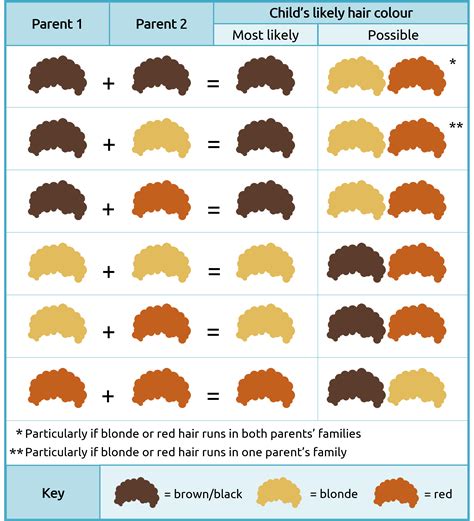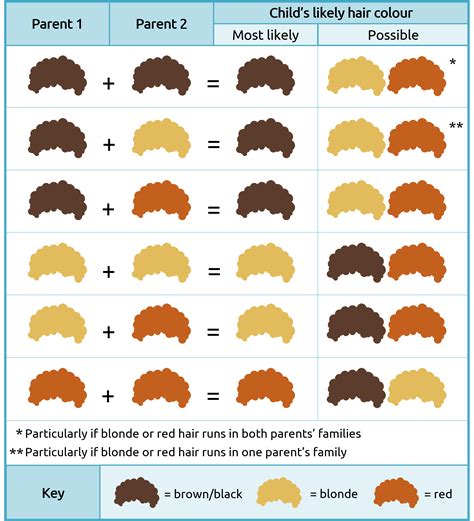Unlock Your Hair Color Genetic Code

Discover the secrets behind your hair color and unlock a world of personalized beauty and styling options. Did you know that the pigments responsible for your hair's unique hue are influenced by a combination of genetic factors? In this article, we will delve into the fascinating science of hair color genetics, explore the different types of hair pigmentation, and provide you with valuable insights to enhance your hair care routine.
Understanding the Genetic Code of Hair Color

Your hair color is determined by the intricate interplay of various genes inherited from your parents. These genes regulate the production and distribution of melanin, the pigment responsible for hair, skin, and eye color. There are two main types of melanin: eumelanin and pheomelanin.
Eumelanin: The Dark Pigment
Eumelanin is the primary pigment found in individuals with black, brown, and dark blonde hair. It is produced by specialized cells called melanocytes, which reside in the hair follicle. The amount and distribution of eumelanin contribute to the depth and intensity of hair color. Individuals with high levels of eumelanin tend to have darker and more rich-toned hair.
| Hair Color | Eumelanin Level |
|---|---|
| Black | High |
| Dark Brown | Moderate |
| Light Brown | Low |

Pheomelanin: The Red and Blonde Pigment
Pheomelanin, on the other hand, is responsible for the vibrant red and golden blonde hues. It is more commonly found in individuals with fair skin and is associated with a lighter hair color spectrum. While eumelanin provides the base color, pheomelanin adds warmth and dimension to hair, creating the beautiful shades of red and blonde.
| Hair Color | Pheomelanin Level |
|---|---|
| Red | High |
| Blonde | Moderate to High |
| Dark Blonde | Low to Moderate |
Exploring the Diversity of Hair Colors

Beyond the primary pigments, the human hair color palette is incredibly diverse. Let’s explore some of the fascinating shades and their genetic influences:
Ash and Silver Hair
Ash and silver hair colors are often associated with aging and natural hair graying. However, some individuals may inherit genes that promote early graying or have a natural tendency towards these cool-toned shades. The absence of melanin in the hair shaft can create these stunning silver and ash hues.
Auburn and Chestnut
Auburn and chestnut hair colors are characterized by their rich, warm tones. These shades are a result of a unique combination of eumelanin and pheomelanin. Individuals with a higher ratio of pheomelanin production tend to have these beautiful reddish-brown hues.
Strawberry Blonde and Copper
Strawberry blonde and copper hair colors are truly captivating. They are a delightful blend of blonde and red, showcasing the beauty of pheomelanin dominance. These shades often have a brighter and more vibrant appearance, adding a unique charm to one’s hair.
Unleashing Personalized Hair Care
Understanding your hair color genetics can be a game-changer when it comes to hair care and styling. Here are some tips to enhance your hair care routine based on your hair color:
Dark Hair Care
- Deep conditioning treatments are essential for maintaining the health and shine of dark hair. Use hair masks enriched with natural oils to nourish the hair shaft.
- Opt for gentle, sulfate-free shampoos to avoid stripping away the natural oils, which can make dark hair appear dull.
- Consider using color-depositing shampoos to enhance and maintain the richness of your hair color.
Red and Blonde Hair Care
- Red and blonde hair can be more porous and prone to fading. Use hair products specifically formulated for color-treated hair to maintain vibrancy.
- Apply a leave-in conditioner or a lightweight oil to protect the hair from environmental damage and prevent dryness.
- Regular trimming is crucial to keep the hair healthy and prevent split ends, which can be more common in lighter hair colors.
Gray and Silver Hair Care
- Embrace your natural silver hair with confidence! Avoid harsh chemicals and opt for natural hair care products.
- Use a purple shampoo to neutralize any yellow tones that may appear over time.
- Silver hair can be more susceptible to dryness, so ensure you use hydrating hair masks regularly.
The Future of Hair Color Genetics
As genetic research advances, we can expect exciting developments in the field of hair color science. Scientists are exploring the potential of gene editing technologies to manipulate hair color, offering new possibilities for personalized hair transformations. Additionally, a deeper understanding of hair color genetics can lead to more targeted hair care products, tailored to individual needs.
Can hair color change over time?
+
Yes, hair color can change naturally as we age. Environmental factors, such as sun exposure and pollution, can also impact hair color. Additionally, certain hair treatments and dyes can alter the natural pigment.
Are there any health implications associated with hair color genetics?
+
While hair color genetics primarily influence pigmentation, some studies suggest a link between certain hair colors and specific health traits. However, more research is needed to establish conclusive findings.
Can I change my hair color based on my genetics?
+
Currently, hair color transformations are primarily achieved through dyeing and other cosmetic procedures. However, with advancements in gene editing, the possibility of genetically altering hair color may become a reality in the future.



